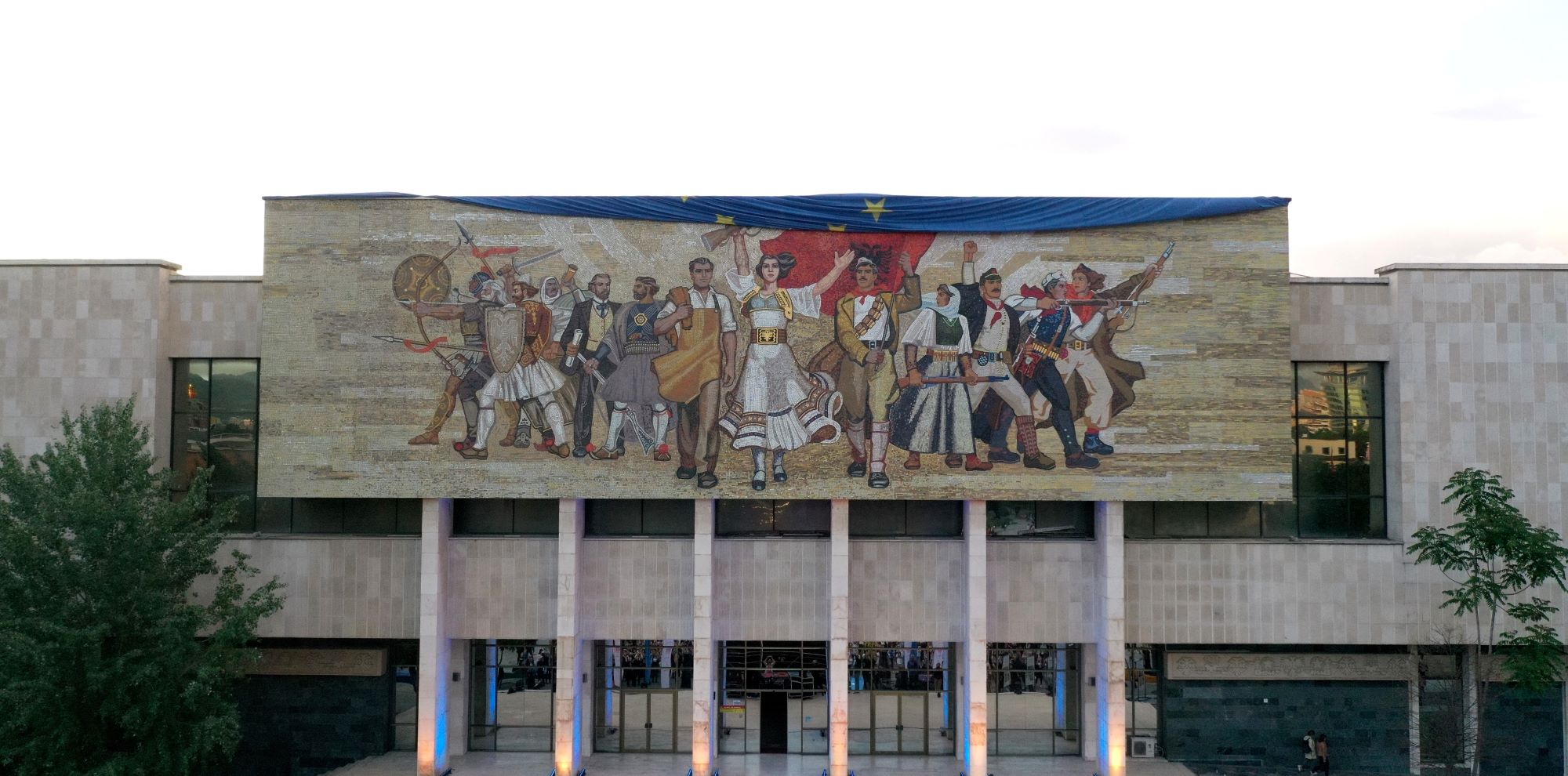National Institute for Cultural Heritage (IKTK)

The iconic mosaic of the façade of the National Historic Museum is considered to be one of the finest examples of late Albanian Socialist Realism. Installed in 1981, it showcases some of the important milestones of the country’s history, spanning from antiquity to the Communist era, across its 565 m2 surface area. Its intricate design was crafted by the renowned artists of the time, including Vilson Kilica, Josif Droboniku, Agim Nebiu, Anastas Kostandini, and Aleksandër Filipi.

In November 2019, Albania was struck by the deadliest earthquake in the past 50 years, with a magnitude of 6.3 on the Richter scale. Its effects were devastating, causing extensive damage across 11 municipalities, including numerous cultural heritage sites, with the Mosaic being one of them. In response to this crisis, the European Union (EU) launched the EU4Culture project, implemented by the United Nations Office for Project Services (UNOPS) in close partnership with the Ministry of Culture of Albania. This project focuses on renovation and revitalization of cultural heritage sites that were damaged by the earthquake, and is one of the largest cultural heritage programs funded by the EU worldwide, with a total budget of €40 million. EU4Culture also aims to enhance Albania’s tourism potential, thus directly contributing to local and regional socio-economic recovery.

In May 2021, EU4Culture assembled a multidisciplinary team of experts, comprising engineers, technologists, conservation and restoration specialists, and the original artists working on the Mosaic in the 1980s, to create an on-site atelier and commence the restoration process. After careful deliberation and in consultation with some of the authors, the team determined the most suitable approach to restoration with a focus on preserving the original elements to the greatest extent possible, taking into account both the original techniques and materials used, as well as modern technological developments in conservation and restoration.

The team began restoration efforts, confronting a number of challenges: to prevent damage to the facade, a self-standing scaffolding had to be constructed, measuring 22m in height and not anchored to the mosaic at all, posing an exceptional engineering project in itself. It took significant time and effort to identify an optimal solution, with a particular focus on workers safety.

The EU4Culture team faced the formidable challenge of conserving 565 m2 mosaic surface area, an area greater than the size of a basketball court. To achieve this, the conservators had to painstakingly document the mosaic stone-by-stone by hand, using a plastic net and tracing paper. This involved analyzing and recording 123 distinct color tones and hundreds of thousands of individual stones (tesserae) at a 1:1 scale. EU4Culture employed a win-win solution by engaging students from the University of Tirana. This approach not only provided experts with additional support, but also gave the students a chance to gain practical experience by working alongside experienced professionals and to apply their theoretical knowledge into practice.

Upon further inspection, it was discovered that water leaking through the roof and penetrating through the cracks in the mosaic had caused the iron reinforcement bars beneath the surface to rust and expand, forming cavities. Additionally, some of the original pigments in the tesserae reacted badly to the exposure to moisture and changes in temperature resulting in fractures. To remedy the situation, the roof had to be repaired, totalling to 859sqm of roof surface. In doing so, it was discovered that the roof layers added over the years were five times thicker than had been anticipated during the design phase. As a result, more than 437 tons of debris had to be removed and the roof was re-laid with new hydro insulation and leveled to direct rainwater away from the mosaic.

The Mosaic authors assisted EU4Culture team in ordering and purchasing tesseras from the factory based in Venice, Italy, that originally crafted them 40 years ago. This was no easy task, as the experts had to consider a multitude of complexities, such as sourcing the minerals, the impact of external temperatures, external humidity levels, thermal fluctuations on production days and nights, and many other factors. Unfortunately, some of the minerals used for producing the original tesserae were no longer available, and chemists and technologists had to go the extra mile to identify and create materials that matched the original color tones precisely.

The restorers divided the Mosaic into segments and worked on each damaged segment as a panel in the atelier, set up in the museum, replacing rusted iron bars and tesserae with new ones in the affected areas. Over the course of 22 months, they meticulously conserved the entire surface of the mosaic. The total budget of the works amounted to almost one million EURO, based on the current exchange rate).

The restoration works of the National Historical Museum building and reconceptualization of museum displays are set to continue in the second half of 2023. Through EU4Culture a new design developed to upgrade the Museum up to modern international standard. The vision for the future of the museum is to upgrade it to feature state-of-the-art technology, interactive exhibits, and a modern design that will provide visitors with an immersive experience to explore the country’s rich heritage and culture.




